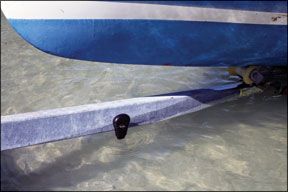The concept behind Quality Mark Inc.s Launch Alert is simple: A 12-volt DC wireless receiver/alarm plugs into a cigarette lighter outlet in the towing vehicle, and a waterproof, battery-operated transmitter/sensor mounts on the trailer. To install, you attach the transmitter (using a very sticky peel-and-stick backing) to the trailer frame so that its sensors are at your desired “waterline.” When the contacts are immersed, the receiver in the vehicle beeps loudly.

y
Youre probably thinking what we were: bilge alarm. Indeed, it will work as a bilge alarm, too, although wed opt first for a hard-wired alarm and use this as a backup. (If it were fully battery-operated, it might be a useful bilge alarm on boats without DC systems.)
It took five minutes to install the Launch Alert, and it worked as advertised, immediately sounding when the test trailer hit the right spot. Testers noted that once the sensor is wet, the alarm continues to sound even when the sensor is no longer in the water. So if you back too far and want to pull out and use it again, you must manually dry the sensors off, or wait for them to dry, which can take several minutes. Also, contrary to what the product description implies, the Launch Alert does not indicate water depth. It tells you when youve backed far enough for launching at the ramp where you installed it. Generally, this initial setting will work at other ramps at various tides, but not always.

Finally, there is a minor concern that if the Launch Alert fails to sound, you might continue backing up until your socks get soggy.
With its $50 pricetag, we wouldnt put it on our must-have list, but if you do a lot of trailering by yourself, it will come in handy. We plan to keep using this on our boat and will report back if anything worth noting crops up.







































